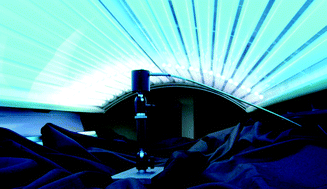Indoor tanning is common in spite of its classification as carcinogenic. Too high an ultraviolet (UV) irradiance and a lack of compliance with regulations have been reported. We measured UV irradiance from a large number of Norwegian solariums (sunbeds and stand-up cabinets) currently in use. Compliance (solariums and facilities) with national regulations and the effect of inspections delegated to local authorities (since 2004) were also studied. In 2008, 78 tanning facilities were selected from six regions throughout Norway that contained municipalities with and without local inspections. UV irradiance was measured with a CCD spectroradiometer in 194 out of 410 inspected solariums. Mean erythema weighted short (280–320 nm) and long (320–400 nm) wave UV irradiances were 0.194 (95% confidence interval (CI) 0.184–0.205) and 0.156 (95% CI 0.148–0.164) W m−2, respectively. Only 23% of the solariums were below the UV type 3 limit (<0.15 W m−2, short and long wave). Irradiances varied between solariums: spectral UVB (280–315 nm) and UVA (315–400 nm) irradiances were 0.5–3.7 and 3–26 times, respectively, higher than from Oslo summer sun. In total, 89.9% of the tanning facilities were unattended. Overall compliance increased since the first study in 1998–1999, but total UV irradiance did not decrease, mainly because of higher UVA irradiance in 2008. Solariums have become even less similar to natural sun due to higher UVA irradiance. Local inspections gave better compliance with regulations, but irradiances were significantly higher in municipalities with inspections (p ≤ 0.001, compared to without). Unpredictable UV irradiance combined with insufficient customer guidance may give a high risk of negative health effects from solarium use.

You have access to this article
 Please wait while we load your content...
Something went wrong. Try again?
Please wait while we load your content...
Something went wrong. Try again?


 Please wait while we load your content...
Please wait while we load your content...